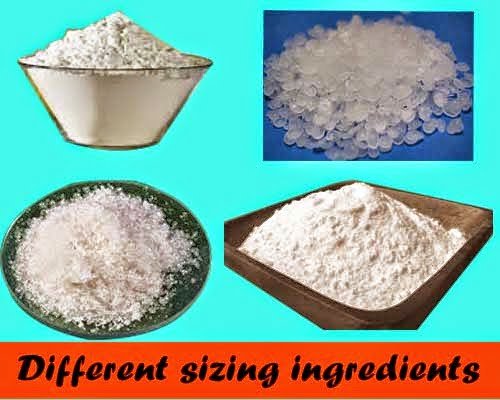A Guide to Different Sizing Ingredients
Last updated on August 12th, 2023 at 01:19 pm
Definition of Sizing Ingredients
The sizing’s fundamental objectives can be achieved only by impregnating the yarn with the appropriate size mixture consisting of various ingredients in suitable proportion. Each ingredient should impart a particular property to the yarn. Accordingly, there are two types of ingredients, namely the primary and secondary ingredients. The primary ingredients are essentially required in the size paste, whereas the secondary ingredients may or may not be added to the size mixture according to the requirements. The primary ingredient is the main ingredient, and it helps to give additional strength to the yarn and improves its abrasion resistance. The other ingredients, known as the secondary ingredients, give additional properties to the yarn such as feel, weight, appearance etc.

Types and List of Sizing Ingredients With Their Functions
The following are the types of ingredients used in sizing –
Primary
- Adhesives
- Softeners/Lubricants
- Antiseptics
Secondary
- Humectants
- Antistatic
- Weighting agents
- Brightening/Bluing agents
- Wetting agents
- Antifoaming agents
Adhesives
Adhesives are those materials that can adhere to the warp yarns throughout the weaving process by increasing the yarn strength and making its surface smooth to withstand abrasion between neighbouring warp threads. The adhesives improve the yarn strength by binding the yarn fibres together, thus making the yarn strong enough to withstand the weaving stresses and strains. In other words, the adhesive is that which binds the fibres together and brings about better cohesion between them. Additionally, the adhesive should have a certain level of viscosity to form a coating or thin uniform film around the surface of the yarn, thereby reducing its frictional resistance and thus reducing abrasion between neighbouring warp threads. Also, the adhesive should bind the protruding fibres to the surface of the yarn.
You may like also: What is Textile Sizing | Objects of Textile Sizing
Several adhesives are available, and these are listed below:
- Starch and starch products – Ex: Maize starch, Tapioca starch, Potato starch, Sago starch, Wheat starch etc.
- Thin boiling starch or soluble starch – Ex: British gum, Dextrin
- Natural adhesives other than starch – Ex: Tamarind Kernel powder, gum Arabic, gum tragacanth, gum Karaya, beam gums.
- Protein substances – Ex: Glue and gelatin, Casein, Soya bean protein.
- Pectin materials – Ex: Alginic acid
- Starch, gum and cellulose derivatives – Ex: Starch ethers and esters, gum guar, Carboxymethyl cellulose.
- Synthetic adhesives – Ex: Polyvinyl alcohol, Acrylic polymers, Vinyl polymers, Polyethylene glycol, Polystyrene etc.
Softeners/Lubricants
These are next in importance to the adhesives. The adhesives produce a film on the yarn, which is rather stiff and renders the yarn inflexible. Hence to make the adhesive film flexible or pliable, the softener is added. Another problem is that the adhesive film on the yarn is not smooth, i.e. has a rough or uneven surface. This tends to generate frictional forces between neighbouring warp threads in the loom during shed formation and between yarn and certain loom parts such as reed, heald eyes etc. The effect would be that the rough coating of size would come off the yarn and subsequently lead to yarn breakage in the loom. Therefore it is necessary to make the yarn surface smooth. The softener thus performs the dual function of making the yarn flexible and smooth. In other words, it also acts as a lubricant. Softeners/lubricants used are the followings –
Ex: Oils and fats, waxes, mutton tallow, oils and emulsions, stearic acid emulsions, vegetable tallow, soaps, sulphated oils and fats, mineral oils, paraffin wax, plasticizers etc. of the many softeners available, mutton tallow is considered to be the best since it acts well as a softener and lubricant.
Antiseptics
These are also known as preservatives. Cellulosic or protein materials which are sized are particularly susceptible to attack by microbiological organisms, moth, insects and mildew. This is due to the hygroscopicity of the textile material and the adhesive with which they are coated. The following antiseptic agents are used in sizing –
You may like also: Definition, Objects and Techniques of Sizing
Metallic salts – Ex: Zinc chloride, copper sulphate, zinc sulphate, sodium silicofluoride.Organic compounds – Ex: Salicylic acid, Phenol, Cresol, Benzoic acid etc.
Among the various antiseptics used, zinc chloride is the best since it acts both as an antiseptic as well as humectants.
Deliquescent
These are basically hygroscopic agents and therefore are also called humectants. They help the sized yarn to regain its moisture and flexibility. In other words, the deliquescent prevent the yarn from over-drying and becoming brittle by retaining the moisture in the cotton yarn at the required level of 8-10% and thereby maintaining the yarn’s flexibility. These are, however, not required in modern sizing machines that are equipped with moisture controllers. The various delinquents used in sizing are Zinc chloride, magnesium chloride, Glycerin, etc.
Antistatics
Though the antistatic agents are considered to be under the category of secondary ingredients, they are important in the sizing of synthetic hydrophobic that is prone to static electricity. Fibres such as polyester, nylon, cellulose acetate are highly prone to static electricity. The static charges generated create problems in the subsequent processes, difficulty in unwinding the weaver’s beams, cloth rolls, and extreme cases, which can even cause fire hazards. Hence it becomes necessary to control the static charge generation. The antistatic agents used are glycerol, polyethylene glycol, lissapol NX. Out of these, Lissapol NX is the best. Besides, several antistatic agents may be anionic, cationic, and non-ionic or amphoteric in nature.
Weighting agents
These are also variously known as weighting agents, filling agents, fillers etc. They help add weight to the yarn to make the fabric get a feel or fullness. This is important when the cloth is to be sold in the grey state on a weight basis. Some of the well-known weighting agents are China clay, Gypsum, Talc or French chalk or soapstone, Barium sulphate, Epsom salt etc.
Brightening/bluing agents
These are colouring/whitening agents. Here too, just as in the weighting agents’ case, these agents are required when the cloth is sold in a grey state. Cotton materials have natural colouring matter, which makes them dull or yellowish in appearance. Hence, to improve the material’s aesthetic
look, they are generally made whiter or given a bluish tinge. Some of the well-known brightening/bluing agents used are Ultramarine blue, acid dyes, fluorescent brightening agents etc.
Wetting agents
In synthetic textile materials such as polyester, nylon etc., natural adhesives such as starch cannot wet the fibres, since they are hydrophobic in nature. Therefore synthetic adhesives will have to be applied with some suitable wetting medium. The wetting medium which is ideally suited for the purpose is Turkey red oil. Other oils such as P4 oil can also be used.
Antifoaming agents
During the sizing, there is always the possibility of foam generation in the sow box’s size. The foam is generated by surface-active agents present in size paste such as soaps, Turkey red oil etc. Alkali foam is formed due to the churning action of the squeezing rollers. The foam that is carried by the warp sheets and causes smudging of the drying cylinders. Hence to reduce the foaming tendency of the size paste, anti-foaming agents are to be added. Some of the well-known anti-foaming agents used are amyl alcohol, turpentine, pine oil etc.
You may like also: Slasher Sizing Machine




Sir one request how to know percentage of solid contend in sizing chemicals
Woah! I’m enjoying the template/theme of this website. It’s simple, yet effective. A lot of times it’s very hard to get that “perfect balance” between superb usability and visual appeal. I must say you’ve done a very good job with this.
My rather long internet look up has at the end of the day been compensated with pleasant insight to talk about with my family and friends.